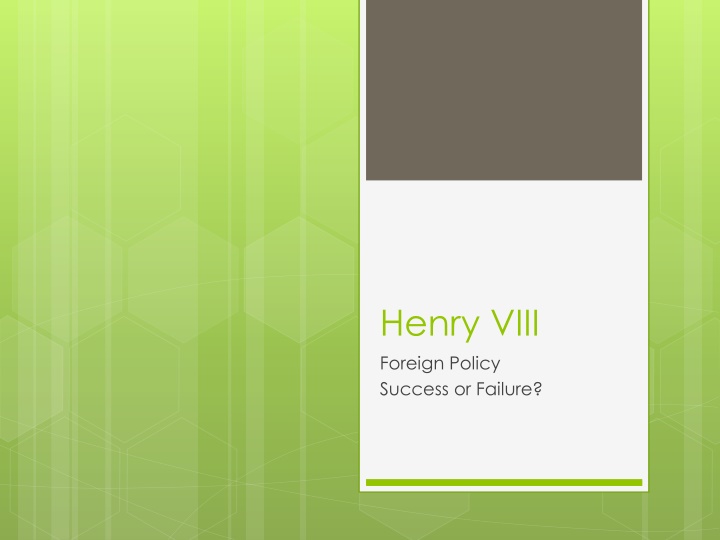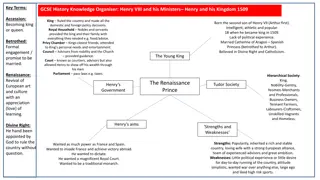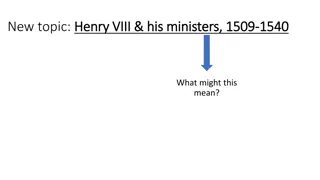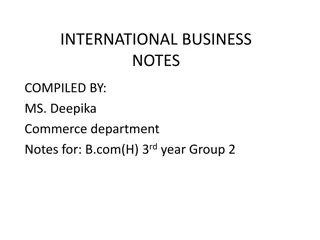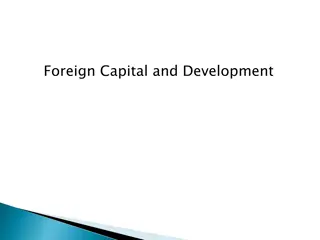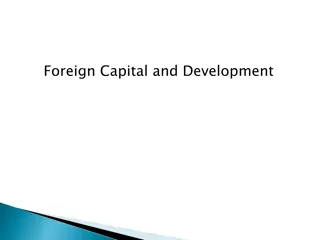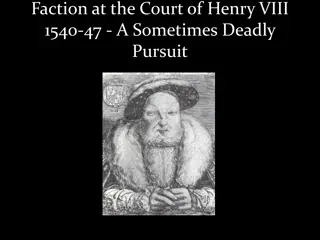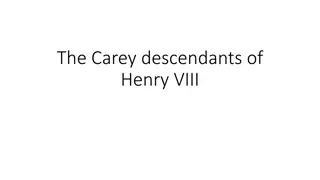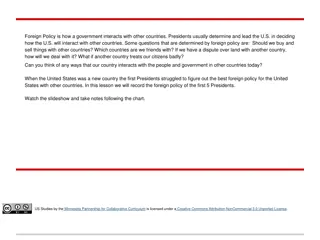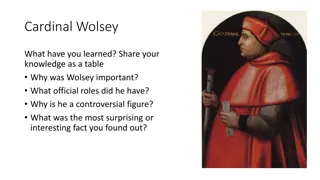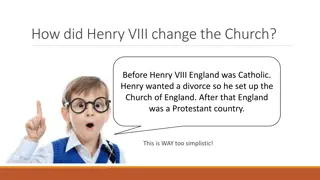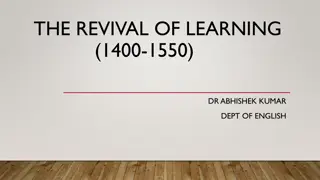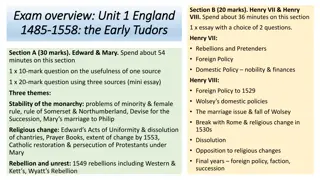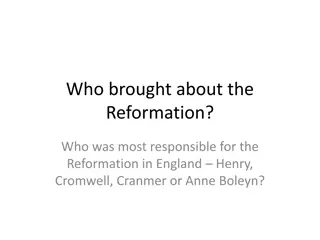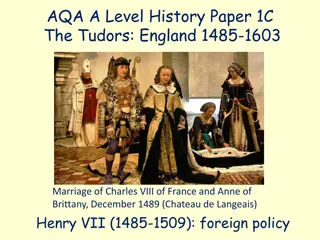Analysis of Henry VIII's Foreign Policy Success and Failure
An overview of Henry VIII's foreign policy up to 1547, discussing the shift in his approach during the 1530s and the revival of ambitions in the 1540s. The content explores traditional and revisionist views on Henry's foreign affairs, including his involvement in Scotland and France, alliances with Charles V and France, and the impact of domestic affairs on his foreign ambitions.
Download Presentation

Please find below an Image/Link to download the presentation.
The content on the website is provided AS IS for your information and personal use only. It may not be sold, licensed, or shared on other websites without obtaining consent from the author.If you encounter any issues during the download, it is possible that the publisher has removed the file from their server.
You are allowed to download the files provided on this website for personal or commercial use, subject to the condition that they are used lawfully. All files are the property of their respective owners.
The content on the website is provided AS IS for your information and personal use only. It may not be sold, licensed, or shared on other websites without obtaining consent from the author.
E N D
Presentation Transcript
Henry VIII Foreign Policy Success or Failure?
Overview of Henrys Foreign policy to 1547 Is it an irony that so much change occurred in the 1530 s during the reign of a monarch who was essentially a medieval king in his approach to foreign affairs? Domestic affairs meant that much of Henry s foreign ambitions were put on hold during the 1530 s. But 1540-47 saw a revival of his aims and these would add to the problems of his people.
Traditional view: A.F. Pollard, Henry VIII (1902), followed by R. B. Wernham, Before the Armada (1966) Interest in Scotland centred on large-scale plan to rule all of Britain. Supporting evidence: Incorporation of Wales into England between 1536 and 1543 Council of the North reformed in 1537 Council of the West formed in 1539 Henry assumes title King of Ireland in 1541. Therefore war with Scotland is part of this grand design of a unified Britain. Hence the rough wooing the engagement of Edward to the infant Mary Queen of Scots The war with France was more personal and a product of martial ambition. It was an interruption to Henry s main business in the north.
Revisionist view: Scarisbrick (1968) Scotland was secondary to France: Henry becomes involved in Scotland to prevent back door attack prior to attack against France. Early success in Scotland sucked Henry into Scottish affairs more deeply than originally intended. The administrative reforms of the 1530s (of which more later), including council of the North, Union with Wales, Council of the West, were more a result of Cromwell s policy rather than anything initiated by Henry himself.
The 1530s sees Henry mainly in a defensive role which went against the grain for Henry. Up to the time of the divorce Henry s main ally had been Charles V through marriage and trade (England and Netherlands). Also because Scotland allied with France and Henry claimed the French throne. Divorce and religion split the alliance between Charles and Henry.
Therefore an Anglo-French alliance seemed a distinct possibility except for the fact that Charles and Francis remained at peace from 1529-36. 1536 saw renewal of conflict between the two great powers over claims on Milan. The death of Catherine of Aragon made the renewal of Anglo-Hapsburg alliance a possibility. (Also Anne Boleyn was executed in 1536). BUT 1536 was not a year for military action abroad due to the pilgrimage of Grace.
Worse was to follow: 1538 saw the declaration of a ten-year truce between Francis and Charles. With the urging of the Pope they even considered a crusade against England!! With Scotland there as well, England felt particularly vulnerable. A morsel amongst these choppers Thomas Wriothsley.
The Truce of Nice helps explain the disastrous Cleves marriage. It was about making overtures to the German Protestant princes and thereby placing pressure on Charles V. Henry did not trust the Lutheran justification by faith alone so the Cleves marriage represented an alternative to doctrinal compromise. Additional motives may have included the possibility of more heirs
The fall of the white rose The Truce of Nice also helps explain the downfall of the remaining Yorkists. Two families were the Poles and the Courtenays. The immediate cause was the involvement of Reginald pole in the proposed crusade against England. November 1538 saw the arrest of Henry Pole, Henry Courtenay, Marquis of Exeter and Sir Edward Neville. Execution followed in December. Margaret, Countess of Salisbury was imprisoned.
His brother Geoffrey confessed to family involvement in treasonable activities. Margaret was executed in 1541, 42 years after the execution of her brother the Earl of Warwick by Henry VII. Spookily Henry Pole s small son was imprisoned and disappeared. But ultimately, the resumption of hostilities between Charles and Francis left Henry with a marriage he neither needed nor wanted but the possibility that he could finally go on the offensive.
After 30 years on the throne the last ten years must have galled Henry in respect of his involvement in Europe. After the changes of the 1530 s he could now get back to his real purpose in life and let rip in France! There s a sense of trying to recover his lost youth !
Anglo-Scottish relations By 1540 the Franco-Hapsburg alliance was in trouble and Henry would have hoped to rebuild the Anglo-Hapsburg alliance. Firstly he needed to subdue the Scots and his nephew James V. Henry felt that James lacked the proper respect that he was due as his uncle and as a major European monarch. The Scots however were anti-English and anti- Protestant as exemplified by the leading churchman in the Scottish court, Cardinal- Archbishop David Beaton. Noticeably James had married twice, both times to French princesses, most recently Mary of Guise.
In 1541 Henry arranged to meet James at York to impress upon him his views and personality. This was Henry s first journey north. James failed to arrive at York and Henry suitably snubbed prepared an assault upon Scotland. 1541 also saw the end of the Franco-Hapsburg alliance. In summer of 1542 Henry and Charles agreed a joint attack on France in the summer of 1543 but first he needed to subdue the Scots at his rear! In October 1542 Henry launched his attack on Scotland. The Duke of Norfolk led his forces. Initially wary of going to war the Scots mood was altered by the savagery and destruction of Norfolk s initial campaign where six days were spent looting, burning and wrecking before returning to Berwick.
On the 23rd November a Scottish force of around 20,000 men advanced on smaller English army at Solway Moss. The Scots were routed and two weeks later James V died (supposedly from shame). He was succeeded by his infant daughter Mary Queen of Scots. Unexpectedly the door was open for Henry to gain clear and permanent control of Scotland whereas the original aim had been to ensure Scottish passivity whilst attacking France. It was enough of a possibility for Henry to postpone the French campaign for a year.
Initially things looked promising. The new Regent of Scotland, the Earl of Arran, seemed ready to co-operate with Henry and arrested David Beaton. The Scottish parliament sanctioned a translation of the Bible. Most importantly negotiations began to marry Prince Edward to the infant Queen Mary. This was enshrined in the Treaty of Greenwich of 1543. Arran had hopes of being King as next in line: he was stringing Henry along. When Henry demanded the end of the French alliance Arran and the Scots parliament repudiated the Treaty of Greenwich, Beaton came back to power and the Auld Alliance was firmly re-established.
Cardinal- Archbishop David Beaton of St Andrews, the pillar of the Franco-Scottish alliance
James Hamilton, Earl of Arran (1516-75)
If only Henry had realised that only armed conquest could win Scotland on a permanent basis. Henry s reaction to being outmanoeuvred was to instigate the rough wooing the burning of Edinburgh and the lowlands by the Earl of Hertford, Edward Seymour (the future 1st Duke of Somerset) in 1544. Despite the vicious and efficient execution of this policy and despite its repeat in 1545 there was no chance of the Scots surrendering to this type of pressure. In reality it cemented the alliance between France and the Scots
Foreign Policy in France In 1544 Henry launched his attack on France. The plan was a two-pronged attack on Paris, which would quickly bring France to her knees. Lacking decisiveness Henry (and his army) lacked the necessary speed. Despite the size of the army (48,000 men left England) success was always unlikely, not only due to the lack of speed, the age of not only Henry but also the two principal English commanders, the Dukes of Norfolk and Suffolk, but also because of the inherent mistrust between Charles and Henry. Henry had thirty years experience of being let down by his allies . The result was that neither followed the plan through and both sided blamed each other for the failure of the plan.
Foreign Policy in France Henry ignored Paris and divided his forces. Norfolk unsuccessfully besieged Montreuil but Suffolk and Henry captured Boulogne on 18th September, the same day that Charles made peace with France. The only prize of this expedition then was Boulogne and Henry would not let this go! This decision had important implications for England.
As a port it was difficult to defend but Henry had it garrisoned and rebuilt to withstand French attacks. In 1544 the cost of its maintenance was 130,000. This brought the total cost of the campaign to 1 million. In 1545 the French launched a counter-invasion against the English coast with the intention of capturing the Isle-of-Wight. Henry s pride and joy, the Mary Rose, was sunk with the loss of 500men. In 1546 Henry signed the Treaty of Camp in June. Henry was allowed to keep Boulogne for eight years and was granted a resumption of the pension won by Edward IV in 1475. Henry s final foreign escapade had been a futile disaster.
Henrys pride and joy: launched in 1511, rebuilt in 1536, sunk in 1545
We tend to see the divorce, the break with Rome and the Royal Supremacy as the central events of Henry s reign but it is likely that Henry saw these as necessary interruptions in his primary task as king winning glory on the battlefield. Henry dictated policy personally. Even in 1546 when councillors were urging peace upon him, Henry was ordering different groups of councillors to negotiate with France and the Emperor, oblivious to the other group s orders. But also, Henry had no Wolsey or a Cromwell to act for him both of whom would undoubtedly have urged caution...
By himself his diplomatic and military skills did not match up to his own dreams. The final word lies with Stephen Gardiner: We are at war with France and Scotland, we have enmity with the Bishop of Rome; we have no assured friendship here with the emperor and we have received from the landgrave, chief captain of the Protestants, such displeasure that he has cause to think us angry with him . Our war is noisome to our realm and to all our merchants that traffic through the Narrow Seas .
Economic Policy By the 1540 s the cost of war had risen enormously. The economic planning of Henry s council was defeated by the huge cost of defences (at Berwick, Calais, Boulogne and south-coast ports). Mercenaries were expensive, the army was huge and the wars lasted longer than planned for. The financial impact on the English economy of Henry s wars was disastrous. Prices rose dramatically between 1540 and 1560 The major cause of this was the measures taken to pay for Henry s wars, which affected everybody in England in the most harmful and practical way by increasing the prices of the food, they ate and devaluing the wages they received.
The basic equation is a familiar one. The ordinary revenue was inadequate for war. Therefore taxation was necessary to cover the costs. This equalled an annual extraordinary income twice as big as Henry s normal revenue. BUT even this parliamentary taxation could not make up the shortfall. The council had to come up with new measures at the same time as inflation defeated their calculations.
War demonstrated the limitations of parliamentary taxation. Subsidies were granted in 1543 and 1545 but were still being collected in 1544 and 1546. 430,00 was collected, a huge amount in such a short time. However the actual amount was still six per cent less than the target yield (as opposed to the usual 1 per cent). In 1542 and 1545 Henry also raised forced loans of over 110,000. This brought him a total of 650,000 from traditional extraordinary sources.
Yet this was only one-quarter of what was needed. Desperate needs equal desperate measures. The sale of royal lands and the debasement of the coinage. Cromwell would have turned in his grave as around half the lands gained in the 1530 s were disposed of. Although around one million pounds were raised the long-term implications for the crown were significant as the loss of land and income would further the crown s reliance on parliament.
Ireland England had never controlled the whole of Ireland. Costs were high and it was virtually impossible to gain complete control due to expense. But from prestige, strategy, dynastic and nationalist perspectives it was inconceivable to give Ireland up. In deed under Henry VIII commitment to Ireland increased.
Stage One: 1509 1530 Henry rules like his father through leading Anglo-Irish nobleman, Earl of Kildare Stage Two: 1530-1540 1534 saw the rebellion by Kildare s son, known as Silken Thomas. Thomas was captured and executed in 1537 Kildare died in prison Suppression of the rebellion cost 40,000 and took 14 months. Cromwell changed policy.
End of delegating power to the Earls. A Lord Deputy who would be English would rule Ireland. Irish parliament revived and permanent military garrison in the Pale. Aim seems to have been to have effective rule in non-Gaelic Ireland but without the intention to extend rule into Gaelic Ireland. In 1536 the Irish Parliament passed legislation which introduced the Reformation, mirroring the laws passed in England including the dissolution of the monasteries.
Stage Three: 1540-1547 1540 new Deputy, Sir Anthony St. Leger attempted to bring Gaelic Ireland under English control in one national state. In 1541 Henry was declared King of Ireland replacing the previous title of Lord. Policy of surrender and regrant - Irish lords gave up their lands which were then regranted to them by the king in return for them becoming vassals of the English crown and introducing English laws to their lands. Irish chiefs gained the security of the king s support against rival claimants. Potentially successful plan which halted in 1543 due to the cost.
